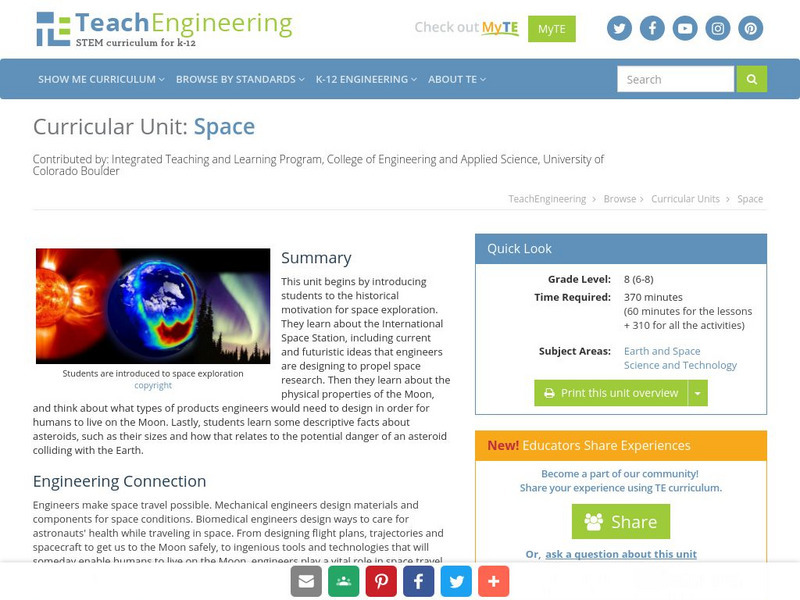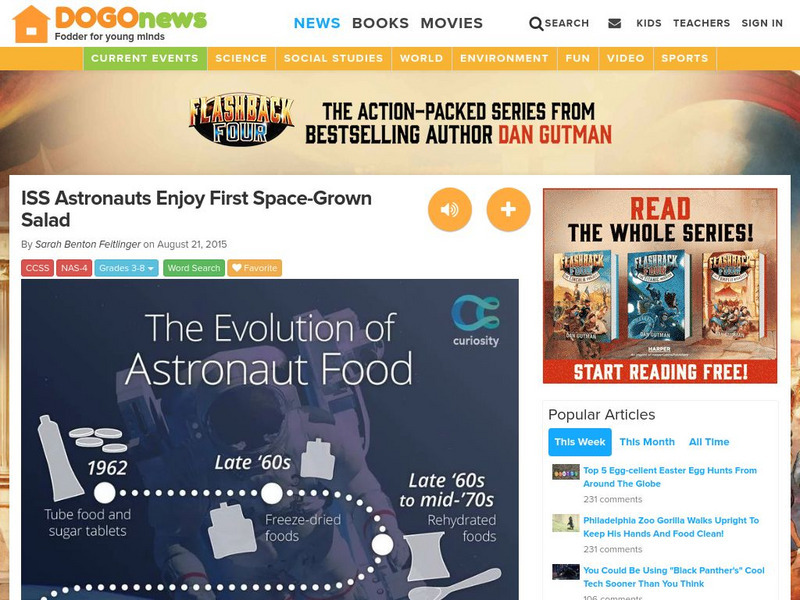Hi, what do you want to do?
NASA
Cleaning Water
Give young scientists a new appreciation of fresh, clean drinking water. After learning about the ways astronauts recycle their air and water, your class will work in small groups creating and testing their very own water...
Education World
Every-Day Edits: Ellis Island
In this proof reading instructional activity, learners read a paragraph about Ellis Island. Students locate and correct 10 errors in the paragraph.
Curated OER
BOUNCING INFORMATION AROUND
Students examine how satellite signals are sent and duplicate it with a mirror, flashlight and black paper.
Florida International University
Simulating Microgravity with Buoyancy
How do astronauts know how to live and work in a weightless environment? It doesn't come naturally! Junior physicists conduct experiments to examine the link between buoyancy and microgravity. Each activity illustrates a different aspect...
Institute for Geophysics
Understanding Maps of Earth
Here is your go-to student resource on primary geography concepts, including facts about the surface of the earth and its hemispheres, latitude and longitude, globes, types of maps, and identifying continents and oceans.
Curated OER
NASA Anniversary
For this NASA Anniversary worksheet, students complete activities such as reading a passage, phrase matching, fill in the blanks, correct words, multiple choice, spelling, sequencing, scrambled sentences, writing questions, survey, and...
Curated OER
Newton's Laws: Making Simple Rockets
Students can use rocketry to understand Newton's Three Laws of Motion.
Curated OER
Simple Rocket Science
Students demonstrate Newton's Third Law of Motion. They discuss the history of rockets, observe how a rocket works, and draw a picture and write an explanation of the balloon experiment.
Curated OER
Aerospace Industry: Vocabulary Skills
In this online interactive vocabulary skills worksheet, students answer 10 fill in the blank questions regarding words related to the aerospace industry. Students may submit their answers to be scored.
Curated OER
Using Infinitives In Context
In this using infinitives in context worksheet, students read an article containing infinitives, then interactively complete 8 sentences with immediate online feedback.
Curated OER
Biotechnology
Students explore biotechnology through various activities. In this biology lesson, students analyze its pros and cons. They study and read informative articles about biotechnology.
Curated OER
Time Line of Astronomy Events and Discoveries
Students work in groups to present a segment of a timeline of events and discoveries in astronomy. In this astronomy lesson plan, students teach their classmates about their section of the timeline.
Curated OER
The X-33 and the X-38
Students explore the relationships among the lengths, areas, and volumes of similar solids. They also discover what effect doubling the dimensions of a figure has on the resulting area.
Curated OER
The Next Logical Step in Astronomy
Students research future astronomy endeavors and how the exploration with contribute to astronomy and humanity. In this astronomy lesson plan, students research, present, and debate the topics as a class.
Curated OER
SETI WebQuest and the Drake Equation
Learners complete a WebQuest where they research the Internet for extraterrestrial intelligence. In this extraterrestrial lesson plan, students also explore how the Drake Equation can predict the occurrence of life elsewhere.
Curated OER
Global Change — Change and Cycles Where Land, Air and Water Meet
Students participate in an experiment to define a parts-per-billion solution. For this ecology lesson, students select a second substance to create a parts-per-billion solution and observe and record their results. Students work in...
Children's Museum
The Children's Museum of Indianapolis: Beyond Spaceship Earth
This unit of study explores the International Space Station through STEM experiences in space science education. Learners become a spacecraft crew and launch from Earth to discover how microgravity affects the orbit of the International...
TeachEngineering
Teach Engineering: Space Travel
Students are introduced to the historical motivation for space exploration. They learn about the International Space Station as an example of space travel innovation and are introduced to new and futuristic ideas that space engineers are...
TeachEngineering
Teach Engineering: Space
In this unit, students first are introduced to the historical motivation for space exploration. They learn about the International Space Station and are introduced to new and futuristic ideas that space engineers are currently working on...
Mocomi & Anibrain Digital Technologies
Mocomi: International Space Station (Iss)
Provides 13 awesome facts about the International Space Station.
DOGO Media
Dogo News: Iss Astronauts Enjoy First Space Grown Salad
Learn how astronauts on the International Space Station are learning to grow their own food in space in order to have fresh vegetables to eat. Includes video.
DOGO Media
Dogo News: Week of 4 11 16: "Year in Space" Brings Us One Step Closer to Mars
Article reports on some of the things learned from astronaut Scott Kelly's year in space, and how that information will contribute to future space exploration missions. Includes video.
NASA
Nasa Space Place: Thermosphere
A brief explanation of the thermosphere home to the International Space Station.


























